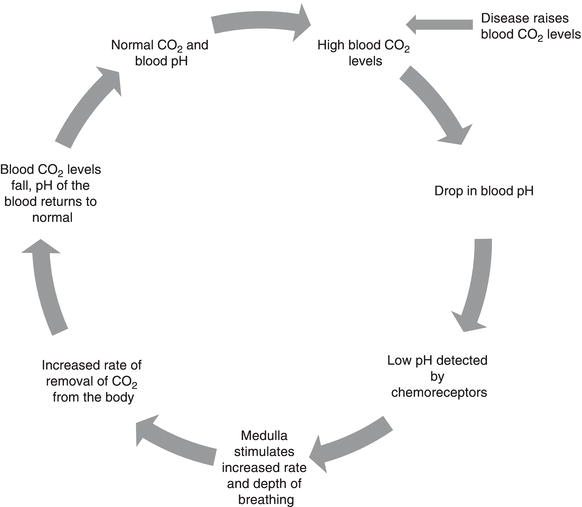- the principles of homeostasis
- the respiratory rate, carbon dioxide and pH
- negative feedback mechanism
- how ill health disrupts homeostasis.
Introduction
We live in an ever-changing environment but despite this, the body needs to maintain its internal environment within strict limits. The process by which the body maintains internal consistency (or internal equilibrium) is termed homeostasis (Chiras 2002). Respiration is one of the many body systems which are regulated by homeostatic processes. This chapter describes this process and gives an example of how it can be affected by ill health.
Respiratory rate, carbon dioxide and pH
Blood pH needs to be held within a neutral range of approximately 7.35–7.45. A lower pH is too acid and a higher pH too alkaline. The body’s metabolism naturally produces acids, most of which are ultimately excreted by the kidneys. Carbon dioxide is produced by all cells as they make energy, and is also acidic. However, carbon dioxide is an acidic gas and so it is removed from the bloodstream by the lungs through breathing. The rate of carbon dioxide removal from the body is proportional to the volume of each breath (bigger breaths remove more carbon dioxide) and the respiratory rate (faster breathing removes more carbon dioxide).
Carbon dioxide dissolved in the blood regulates the respiratory rate
The brain regulates the amount of carbon dioxide in the blood by altering the respiratory rate and depth (also termed the tidal volume). Chemical sensors termed chemoreceptors in the medulla of the brain can determine if carbon dioxide levels have increased by detecting the decreased blood pH caused by the increased carbon dioxide (Chiras 2002). A drop in blood pH is detected by the medulla which then stimulates nerves to the diaphragm and intercostal muscles, increasing the respiratory rate and tidal volume (West 2004). This leads to an increase in the rate of removal of carbon dioxide from the body, and the blood levels of carbon dioxide fall back to normal. This in turn returns the blood pH to its normal level, removing the stimulus which previously increased the respiratory rate and tidal volume, and the tidal volume and respiratory rate settle at this new level (Figure 2.1).
Control of respiratory rate is an example of a negative feedback mechanism
In a negative feedback mechanism, a stimulus causes a response which removes the original stimulus, thus ‘turning off’ the response. You will notice that raised carbon dioxide triggers an increase in respiratory rate, which decreases the amount of carbon dioxide, and the respiratory rate falls again. So, control of breathing by carbon dioxide is an example of a negative feedback mechanism. There are several causes of increased carbon dioxide production, such as exercise or severe sepsis. Negative feedback is a common mechanism used by the body to regulate itself and maintain homeostasis (Clancy and McVicar 2009). Other examples are the control of blood sugar through regulating insulin release from the pancreas and maintenance of blood pressure by regulating the heart rate.
Stay updated, free articles. Join our Telegram channel

Full access? Get Clinical Tree



